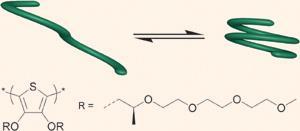A polymer that forms helices when dissolved in water could lead to new materials for bio and electronic applications.
A polymer that forms helices when dissolved in water could lead to new materials for bio and electronic applications. Albertus Schenning, E W Meijer and colleagues at the Eindhoven University of Technology, the Netherlands, investigated a pi-conjugated polythiophene; a compound known to have strong absorptions in the UV-visible spectrum that change when the conformation of the polymer changes.

They found that the absorbance and emission spectra of this polythiophene differed when the solvent was changed from water to tetrahydrofuran, indicating a difference in the conformation of the polymer. It was not clear, however, whether this was due to folding of the individual polymer molecules or to aggregation. The researchers heated aqueous solutions of the polymer to determine the temperature at which the change occurred. They found that this temperature was independent of concentration, signifying that the molecules were folding rather than forming aggregates.
Schenning and his group conducted further experiments to determine the shape of the folded molecules, and found that the polythiophene formed helices in aqueous solution. This is an important result because most polymers tend to form ill-defined aggregates in solution, making them difficult to study. The authors believe that the discovery of this behaviour provides a basis for developing new and interesting materials that will have applications in organic electronics and biosensing.
David J Barden
References
J R Matthews, F Goldoni, A P H J Schenning and E W Meijer, Chem. Commun., 2005 (DOI: 10.1039/<MAN>b512119a</MAN>)






No comments yet